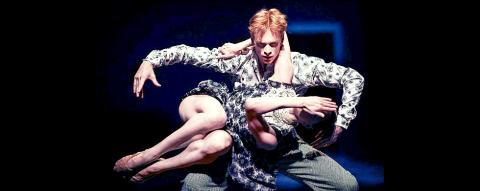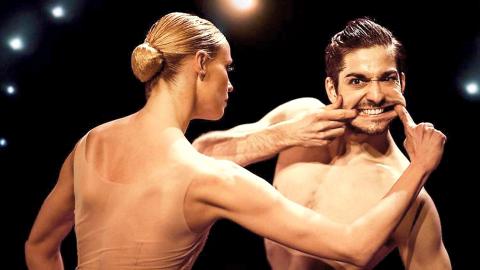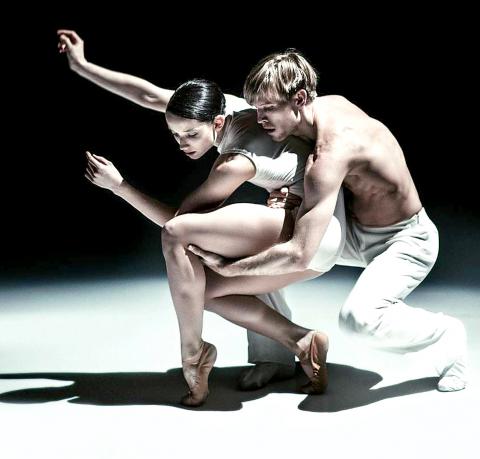The Hague-based Nederlands Dans Theatre (NDT 1) is back at the National Taichung Theater this weekend — its home away from home in Taiwan — for the first of two weekends of performances that will give fans a chance to see a wide variety of dances.
That Taichung is the hometown of NDT 1 dancer Wu Meng-ke (吳孟珂), the first Taiwanese to join the company — in 2013 after three years with NDT 2, its second iteration for younger performers — might have something to do with the company’s repeat visits.
NDT 1 will perform Shut Eye, Woke up Blind, The Statement and Bedroom Folk in Taichung, and then move to Kaohsiung next week to perform Shut Eye, Solo Echo and Safe as Houses as the National Kaohsiung Center for the Arts (Weiwuying) joined with its sister house to coproduce this tour.

Photo courtesy of the Nederlands Dans Theater
The two mixed-bill programs both feature pieces by NDT’s house choreographers Sol Leon and Paul Lightfoot, and Canadian associate choreographer Crystal Pite.
Works by Marco Goecke, who joined the company as an associate choreographer in 2013 and the partnership of Sharon Eyal and Gai Behar, the cofounders of the Israel-based L-E-V Dance Company, will round out the Taichung shows.
CHALLENGING CHOREOGRAPHY

Photo courtesy of Rahi Rezvani
All five are creating some of the most challenging contemporary choreography being performed today.
In Shut Eye, NDT artistic director Lightfoot and Leon ask viewers the question: Is what we see limited by our senses or is it conditioned by how we let our brain manipulate images through our emotions? They use black and white, light and shadow to create a surrealistic fantasy world
For Woke Up Blind, Goecke uses two very different songs by Jeff Buckley, You and I and The Way Young Lovers Do and seven dancers — two women and five men — to explore the intense highs and longings of love.

Photo courtesy of Rahi Rezvani
Pite describes The Statement as a one-act play, where the four characters become locked in a battle over responsibility and their own morality after being ordered to fuel a conflict in a distant country.
For 2015’s Bedroom Folk, Eyal and Behar collaborated with musician Ori Lichtik and set and lighting designer Thierry Dreyfus to create a work in which movement, music and light are equal protagonists.
Pite’s 2012 work, Solo Echo was inspired by Mark Strand’s poem Lines for Winter, where the individual is the focal point against a backdrop of whirling snowflakes.

Photo courtesy of the Nederlands Dans Theater
Lightfoot and Leon’s Safe as Houses for which they not only choreographed, but designed the costumes and set, was inspired by the I Ching and set to music by Bach.
It is a piece that ponders humankind’s reliance on physical environment and the capability to survive.
All the shows are more than two hours — 150 minutes for Taichung and 130 minutes for Weiwuying — with intermissions, for those who might need to make travel plans to see one or both programs.
Performance Notes
WHAT: Nederlands Dans Theater
WHEN: Saturday at 7:30pm and Sunday at 2:30pm
WHERE: The Grand Theater at the National Taichung Theater (台中國家歌劇院) 101, Huilai Rd Sec 2, Taichung City (台中市惠來路二段101號)
ADMISSION: Remaining tickets are NT$500 to NT$1,500, available at the theater’s box offices, online at www.artsticket.com and convenience store ticket kiosks
ADDITIONAL PERFORMANCES: June 21 at 7:30pm and June 22 at 2:30pm at the Opera House at the Weiwuying National Kaohsiung Center for the Arts (衛武營國家藝術文化中心) 1, Sanduo 1st Rd, Kaohsiung City (高雄市三多一路1號); tickets NT$300 to NT$2,200, available as above

In the March 9 edition of the Taipei Times a piece by Ninon Godefroy ran with the headine “The quiet, gentle rhythm of Taiwan.” It started with the line “Taiwan is a small, humble place. There is no Eiffel Tower, no pyramids — no singular attraction that draws the world’s attention.” I laughed out loud at that. This was out of no disrespect for the author or the piece, which made some interesting analogies and good points about how both Din Tai Fung’s and Taiwan Semiconductor Manufacturing Co’s (TSMC, 台積電) meticulous attention to detail and quality are not quite up to

April 21 to April 27 Hsieh Er’s (謝娥) political fortunes were rising fast after she got out of jail and joined the Chinese Nationalist Party (KMT) in December 1945. Not only did she hold key positions in various committees, she was elected the only woman on the Taipei City Council and headed to Nanjing in 1946 as the sole Taiwanese female representative to the National Constituent Assembly. With the support of first lady Soong May-ling (宋美齡), she started the Taipei Women’s Association and Taiwan Provincial Women’s Association, where she

Chinese Nationalist Party (KMT) Chairman Eric Chu (朱立倫) hatched a bold plan to charge forward and seize the initiative when he held a protest in front of the Taipei City Prosecutors’ Office. Though risky, because illegal, its success would help tackle at least six problems facing both himself and the KMT. What he did not see coming was Taipei Mayor Chiang Wan-an (將萬安) tripping him up out of the gate. In spite of Chu being the most consequential and successful KMT chairman since the early 2010s — arguably saving the party from financial ruin and restoring its electoral viability —

It is one of the more remarkable facts of Taiwan history that it was never occupied or claimed by any of the numerous kingdoms of southern China — Han or otherwise — that lay just across the water from it. None of their brilliant ministers ever discovered that Taiwan was a “core interest” of the state whose annexation was “inevitable.” As Paul Kua notes in an excellent monograph laying out how the Portuguese gave Taiwan the name “Formosa,” the first Europeans to express an interest in occupying Taiwan were the Spanish. Tonio Andrade in his seminal work, How Taiwan Became Chinese,